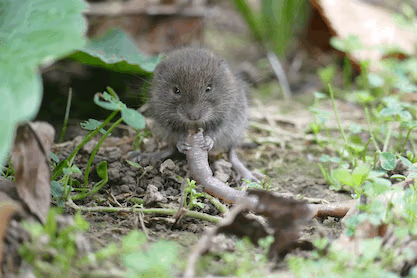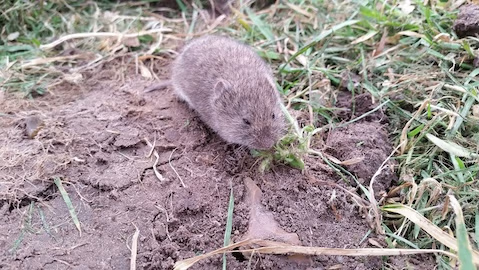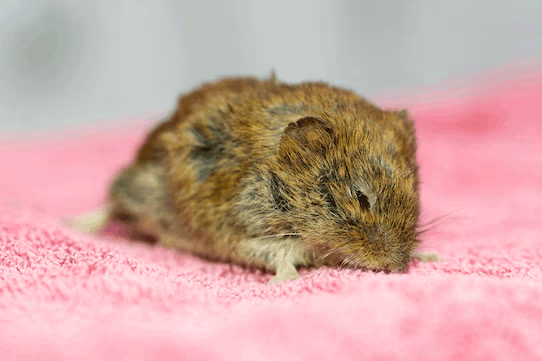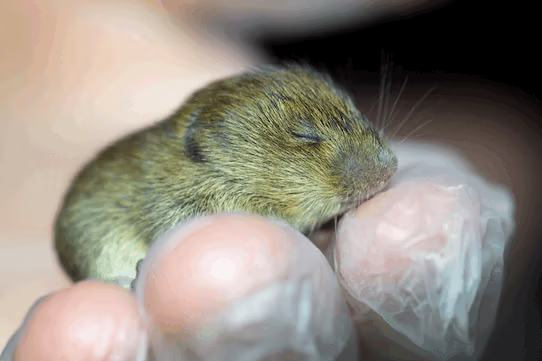Bank Vole
Myodes glareolus
Life History
Length: 8 -12 cm
Tail: 3 – 6 cm
Weight: 15 – 40 g
Diet: Primarily herbivorous, feeding on seeds, nuts, berries, fungi, and roots. Occasionally, they consume small insects or larvae.
Average lifespan: 4-8 months in the wild due to predication; can live up to 18 months in captivity.
When to see them: All year round
UK population: est. 75 000 000 in Britain
UK conservation status: Common

About
The bank vole is a small, adaptable rodent found across woodlands, hedgerows, and gardens. Known for its russet-brown fur, the bank vole has a short tail and small, rounded ears, which help it blend into its forested surroundings. Unlike many of its relatives, the bank vole is active throughout the day, foraging on the ground for food. It plays a crucial role in woodland ecosystems, serving as both a seed disperser and a prey species for various predators.
Bank voles are skilled at creating intricate networks of tunnels and burrows, often with several entrances to help them escape from predators.
Their agility and speed make them adept at navigating dense undergrowth. Additionally, these voles are known to have high reproductive rates, which help sustain their population despite high predation pressure.
Nature’s little gardener, busily planting seeds and keeping the forest in shape—one tiny nibble at a time!
Behaviour
Bank voles are generally solitary, though they may nest in small family groups during colder months. They are territorial, especially around food sources and nesting areas, using scent markings to communicate and defend their space. With a mostly crepuscular (active at dawn and dusk) lifestyle, bank voles rely on their keen sense of smell and hearing to navigate and detect predators. These small rodents are known for their burrowing and caching behavior. In preparation for winter, they often store food in their burrows, which helps them survive when resources are scarce. Bank voles are essential for seed dispersal, as they unintentionally spread seeds and spores in their environment.


Their Threats
How you can help
- Create Wildlife-Friendly Gardens: Leave areas of long grass, dense shrubbery, and leaf litter, which provide shelter and food for voles.
- Reduce Pesticide Use: Minimizing pesticide use supports a healthier ecosystem, allowing insects and plants that voles depend on to thrive.
- Maintain Hedgerows and Woodlands: Preserving natural habitats such as hedgerows and forested areas helps protect voles and other wildlife from habitat loss.
- Encourage Natural Predators: Encouraging natural predators that prey on small rodents, including voles, by creating an environment that attracts animals—like owls—can help maintain a balanced ecosystem without relying on chemical pest control.

Frequently Asked Questions
What should I do if I find a bank vole in my garden?
Are bank voles the same as field voles?
No, bank voles differ from field voles in appearance and habitat preference. Bank voles have a reddish-brown coat and are commonly found in woodlands, while field voles have a more greyish-brown coat and prefer open fields and grasslands.
Are they harmful to my garden or plants?
Generally, voles aren’t harmful; they mostly eat seeds, fruits, and plants. In fact, they help the ecosystem by spreading seeds, though they might nibble a few garden plants.
Are voles a problem for my pets?
Voles aren’t harmful to pets, but cats, in particular, may be interested in them. Keeping cats from hunting helps protect vole populations.